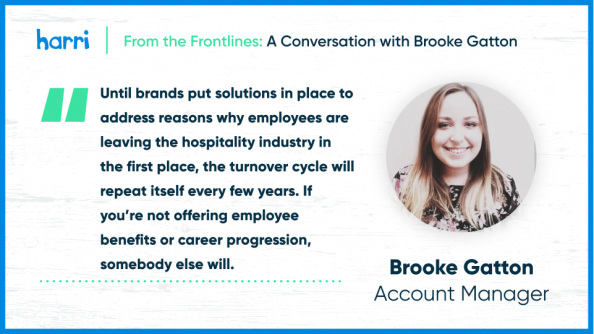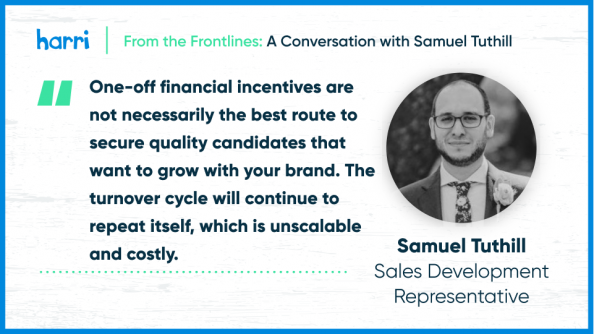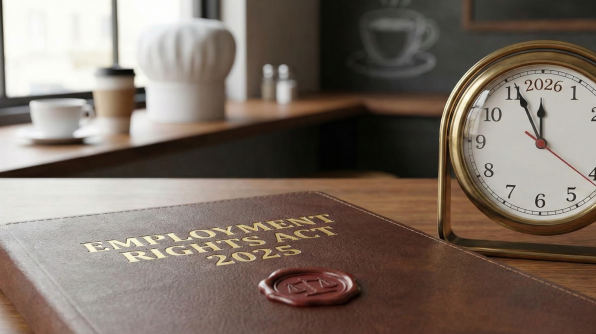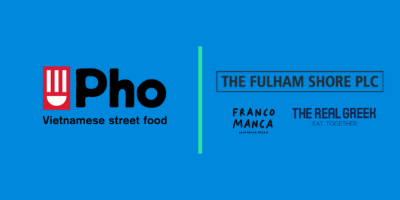Reducing Employee Turnover as Told by Hospitality Experts
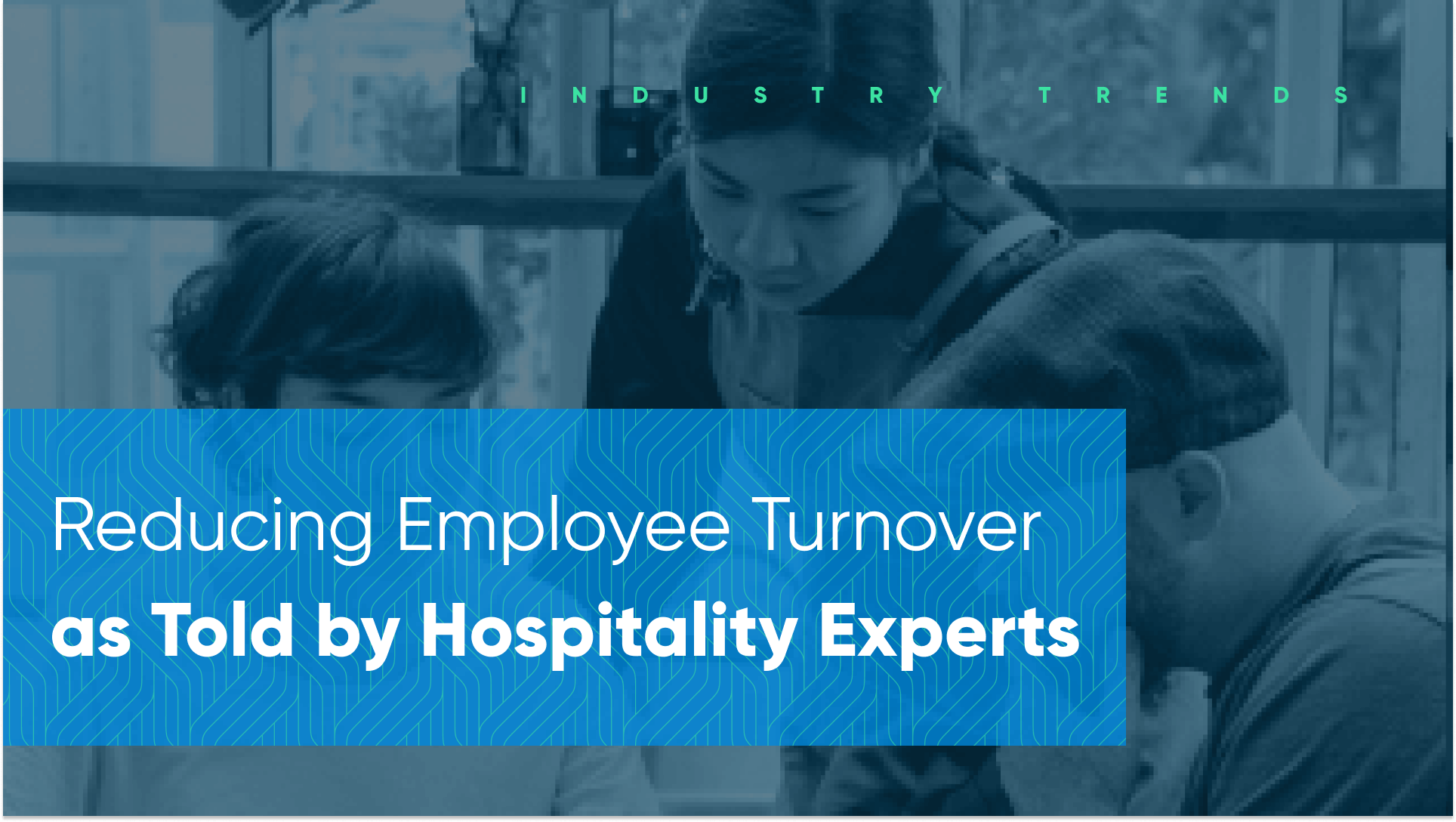
- By Harri Insider Team | February 16, 2021
Kristin Schoenstein, Portfolio Director at Worldwide Business Research, recently hosted a “Future of Restaurants” webinar that discussed major changes that COVID-19 brought upon the hospitality industry, team management, and key cultural drivers for reducing employee turnover. She was joined by Alonso Castañeda, VP of Brand Development & Strategy at Savory Restaurant Group; Amanda Busby, VP of Operations at Red Robin; Dennie Laney, VP of Training and People Development at Mooyah Burgers Fries & Shakes; and Kim Juda, Supply Chain Director of Clean Juice.
The speakers all gave great insights on how their own businesses adapted to industry challenges during COVID-19, how it affected their teams, and essential factors to reducing employee turnover.
Prominent business changes in hospitality
It’s no secret that the restaurant industry has had to make crucial changes in order to adapt to the ever-changing guidelines and regulations being released in response to the COVID-19 pandemic. However, what exactly are these changes, how has it impacted their employees, and what have been the key factors in keeping restaurant employees happy in the midst of all the chaos?
Technology for team reassurance and efficient operations
Changes to the restaurant industry have been quick, dramatic, and constant. As a result, one of the most substantial shifts was the increased reliance on technology. Busby notes that “hope is not an action plan,” and restaurants that crat tech-driven processes will be the first to see the light at the end of the tunnel.
However, the panelists discuss how technology should be more than a tool to create a great guest experience — it needs to make life frictionless for employees.
Thanks to COVID-19, immediate information became more than just a luxury, it’s a necessity. Workplace sanitation policies, alerts to employee virus exposure, or changes to a restaurant’s opening status requires a constant need for quick communication, as noted by Laney.
Juda even mentioned that technology has called out some inefficiencies that many businesses didn’t even know they had until they started using these tech tools.
Smart scheduling is a testament to those pre-existing technology gaps and has proven to be a welcomed tool during the pandemic. Busby points out that modified operations, closed stores, even semi-closed stores all have very different labor needs. She recommended making a playbook for every possible scenario (and sticking to them) to minimize disruption should operations suddenly shift.
When restaurants utilize smart scheduling tools, managers can quickly create cohesive, manageable, and labor-efficient schedules for their employees without taking away from other pandemic-related responsibilities. And if that scheduling tool is part of a fully-integrated HCM platform, connecting the dots between labor needs, compliance requirements, payroll, and more to fully streamline the managerial workload.
Leadership and management styles
Castañeda and Busby both emphasized the importance of going “back to the basics” and doing the simple things right before jumping ahead.
Companies are most likely to let simple tasks slip through the cracks when they’re very overwhelmed or during periods of success. The pandemic has been a great time for restaurants to step back, slow down, and reimplement the forgotten (yet necessary!) aspects of business management.
Castañeda also suggests that although these tasks, such as daily pre-shift meetings, don’t seem as necessary when a restaurant is at 50% capacity, it does not mean they shouldn’t be done. He drove that point home by saying “just because you’re at 50% capacity doesn’t mean you’re offering 50% service.”
Training is another necessary task often overlooked during periods of chaos. But to Busby, finding time to train your employees is vital.
Her mantra of “short-term pain means long-term gain” ensures that all Red Robin employees:
- Feel confident and certified in their role
- Contribute to the greater good
- Feel company culture
After all, there’s nothing more reliable than a trained team member.
The above advice isn’t just to keep the customers happy, but to keep employees satisfied and engaged. When your team is set up for success, they’re able to perform at high levels of efficiency and are more likely to be happy in their role and with the company.
Decreasing employee turnover in hospitality
Employee turnover is not a new problem for hospitality, but COVID-19 only amplified those staffing challenges thanks to mass-layoffs and a mass shift to non-essential industries. Busby advises that “nothing will change the outlook of your business if you don’t have a happy team,” making employee retention a key success factor when battling the pandemic.
Team-driven communications
As discussed before, communication is more important now than ever before. With the constant changes in information that occur daily, employers must keep themselves and their workers well-informed at all times.
Castañeda said that Savory Restaurant Group also began B2E marketing initiatives, curating marketing content regarding company news to their employees. It’s not the same as customer marketing — instead, it’s designed to deliver consistent, informative messages reassuring employees on business status, sanitary policies, and more.
Mobile apps, notifications, and other employee communications tools ensure team members are up-to-date in a way that’s accessible and comfortable for them. They also provide an outlet for employees to confidently alert managers of any concerns that may impact their work availability or performance in a safe space.
Savory Restaurant Group also used surveys to gain an understanding of what their employees want, where they need more training, and what’s working well within the business…and what isn’t. Transparent, two-way communication was critical to the brand’s success.
A growing need for employee support systems
Laney and Busby noted a lot of control has been lost during the pandemic, and focus has shifted more to understanding and caring for employees. Although employees should still be held to a high level of accountability, businesses must be aware that employees are experiencing extreme stress levels far beyond their job responsibilities.
Employers must provide their team with a supportive environment that exudes confidence, trust, authenticity, and transparency. Sometimes that means providing direct support, like technology as mentioned earlier, and sometimes that means creating a flexible work environment.
Castañeda pointed out that employee-focused benefits are a great way to foster employee support by showing you care about their specific needs. Daily pay is a highly requested and easy-to-implement process that doesn’t hurt employers and provides team members with immediate financial support during uncertain times.
Busby’s highlighted the importance of creating an entire employee support ecosystem. She’ll connect with team members of all levels and ask, “what do you need from me for you to execute your job better?”
Closing thoughts of the future of restaurants
Be solution-based. Stay calm. Learn as you go. The Future of Restaurants webinar and all of its panelists gave great advice that doesn’t just apply to the pandemic, but also to the future of hospitality employment as a whole.
COVID-19 has certainly brought its fair share of challenges to the hospitality industry, but it’s important to remember that it also came with some silver linings, particularly in the way restaurant operators approach the employee experience. At Harri, we’re looking forward to continuing to help restaurants drive business performance by enabling them to focus on their greatest asset: their people.











